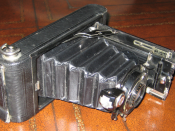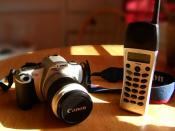Kodak's decision to stop selling traditional film cameras in North America marks the formal end of tradition. It's easier, smoother, more efficient and certainly more expensive today to take pictures on computer chips, converting memories into e-mailable electrons and pixels. These images can be stored, transmitted, printed at home, even erased and reused.
Previous generations of Americans grew up- and can now look back on themselves growing up- with those spools of film wrapped in thick yellow paper that got inserted into cameras, recording whatever family pose, birthday cake, or newborn the camera was aimed at.
The rewound film was then delivered to a store that developed pictures. There the film was turned into snapshots for shipment, scrapbook storage, and souvenir savoring. Fifty years ago, these developments could take a week of excited waiting. Today it only takes 30 minutes if you can even stand to wait that long.
This past holiday season some stores offered old-fashioned-looking console radios, which once dominated American living rooms as TVs do today. These retro-radios made of wood-looking plastic also play tapes and CDs, and when you lift the top there's a round table with a silver spindle and an arm containing a tiny needle that plays something called a phonograph record. Parents could be seen explaining this prehistoric device to modern children, who carry their entertainment in battery-powered, pocket-sized music machines.
It's all part of a process, presumably. Someday, when palm-sized camera's transmit video images directly in to the eyeglasses of distant relatives, our grandchildren will not believe there was anything as primitive as a photo CD, let alone film. Meanwhile, we hope Kodak takes a nice snapshot of the last film camera for sale in North America- and does it on film.



Say Goodbye
Some traditions don't die so easily. "Kodak's decision to stop selling traditional film cameras in North America marks the formal end of tradition" for them, but other companies will probably continue to sell them for some time. There are still a number of people who aren't comfortable with computer technology. They will serve as ready customers for smaller companies who recognize an opportunity to make a little money by serving what is becoming a niche market.
7 out of 7 people found this comment useful.